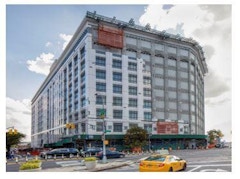
295 results
-
 Factory inspection visits are vital, yet they unfortunately have a habit of being overlooked. The factory inspection process during the Building…
Factory inspection visits are vital, yet they unfortunately have a habit of being overlooked. The factory inspection process during the Building… -

Blast Performance of TSSA
- Paper by Jon H. Kimberlain, Lawrence D. Carbary,
Architectural preferences for commercial building continue towards increased transparency resulting in large lites of glass with minimal visual… -

ETFE Membrane Envelope Strategies
- Paper by Audrey L Worden, ISSF · Kihong R. Ku, DDes · Alexander G. Worden, RA NCARB
Airflow within the cavity of double-skin facades is a key component of adaptive building envelopes which change thermophysical properties to meet
-

Multi Layer Facades
- Paper by Robert Moisy,
The history of high performance facades and glazing has been a tale of attempting to manage the conflicting requirements of, on one hand inviting… -
Cities under Climate Threat - Philadelphia, Rome and Venice
- Paper by Edgar Stach, Dr., Ing, AIA/IA · Shreya Kanther · Alexis Manfre
The impacts of climate change, driven by increasing extreme temperature, sea-level rise, and heavy precipitations, interact and play an essential
-
Behind the Surface
- Paper by Damon Caldwell
The architectural facade, like clothing for a building's form, serves as both an aesthetic expression and a protective veil, concealing the inner
-

Active and Energy Autonomous Window
- Paper by Annalisa Andaloro, Leire Minguez Hilera, Stefano Avesani,
Reducing GHG emissions related to energy use in buildings is a prominent obligation given their impact in terms of climate change. In this light,… -

Prefab Facades – from Prototype to Product?
- Paper by Lisa Rammig, Andrea Zani, Tim Murphy,
Building envelopes are not only an immediately visible part of the building, they have also become a major factor both for cost and performance of… -
Spandrel Thermal Simulation Techniques
- Paper by Ivan Lee · Edlyn Garcia La Torre · Shahima Rahmatipour
Glazed wall systems, such as curtain walls and window walls, are one of the most commonly used façade systems in modern buildings in North America.
-
Orbit Tower
- Paper by Enrica Oliva · Michele Andaloro · Werner Sobek
While most of high-rise buildings feature a core surrounded by a spatial frame defining the volume, one could envision a column-free plan where the
-

Highly Efficient Façades with Innovative Shading and Light Control
- Paper by Klaus Reuschle · Robert Matthew Noblett · Michelle Siu-Ching Lee · Roman Schieber
The Science and Engineering Complex (SEC) on the Allston Campus is the largest new building at Harvard University in recent decades with a footprint
-

Terra Cotta Skins
- Paper by Laura B. Garofalo
This paper will address the potential of ornamental architectural terracotta surfaces to mitigate the effects of climate fluctuations that will
-

Patchwork
- Paper by Alexander G. Worden, AIA,
It may be difficult for modern man to believe that what is known as handicraft was once the advanced manufacturing of the day. These techniques were… -
Facades Education in the United States
- Paper by Ajla Aksamija, PhD · Suncica Milosevic · Gabrielle Brainard · Timothy Brown
This paper presents the results of a research study, outlining the state of facades education at higher-education institutions across the United
-
Saving Face
- Paper by Xsusha CarlyAnn Flandro, FAIC, APT-RP
In 1871, a fourth level Architecture course was offered in New York City that instructed on topics such as heating, ventilation and circulation of
-
Terracotta 1912 to 2018
- Paper by Carol Loewenson, FAIA, LEED AP · Stephen Dietz, AIA, LEED AP
Center Three is a 100-year-old, one million square-foot building in Long Island City, New York that was constructed over the course of one year. It
-

Thermal Analysis of Complex Glazing
- Paper by Adrian Turcato, Chris Stutzki, Erik Olsen,
The use of bidirectional scattering distribution function incorporated in a transient systems simulation program, allows engineers to accurately… -
Insulating Glass Unit Gas Loss
- Paper by Mark K. Schmidt, M.Eng., S.E. · Stephen M. Morse, PhD, P.E.
Concerns over time-dependent argon permeation through the perimeter edge seals of insulating glass units (IGUs) led the authors to utilize two
-

Carbon Lean Facades
- Paper by Stefanie Schober · Jonce Walker, LEED AP, Certified Sustainable Building Advisor, and Fitwel Ambassador
With net zero and carbon neutral mandates on the near horizon, New York City has pushed the green building envelope by leveraging incentive-based
-

Let Thin Glass in the Facade Move
- Paper by Prof. DI Dr. Jürgen Neugebauer, DI Dr. Markus Wallner-Novak,
Facades play an important role in the control of energy flow and energy consumption in buildings as they represent the interface between the outdoor…


